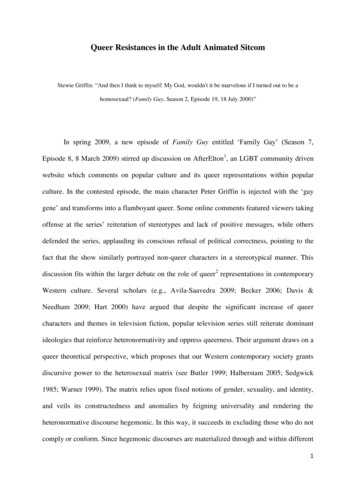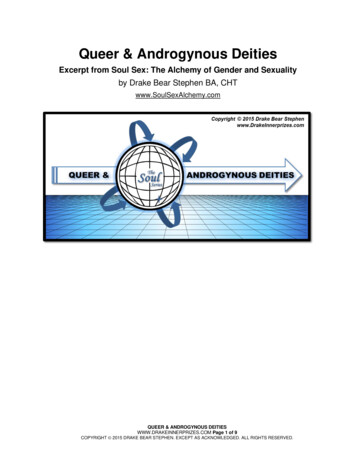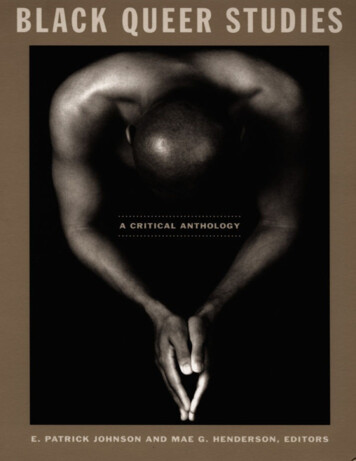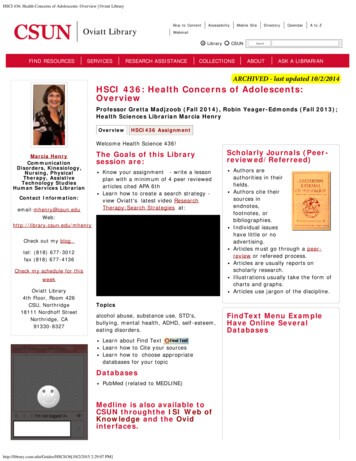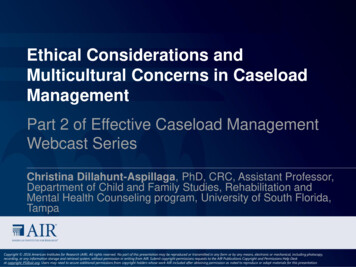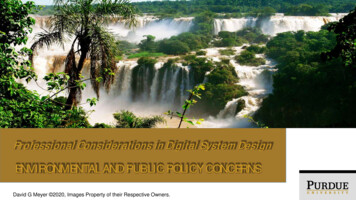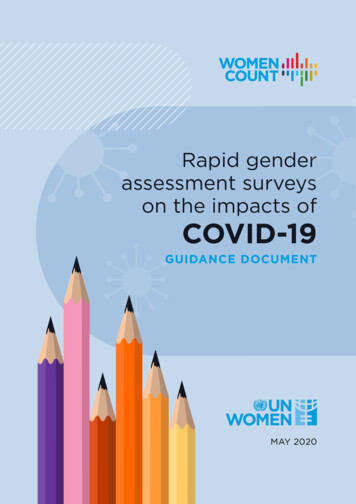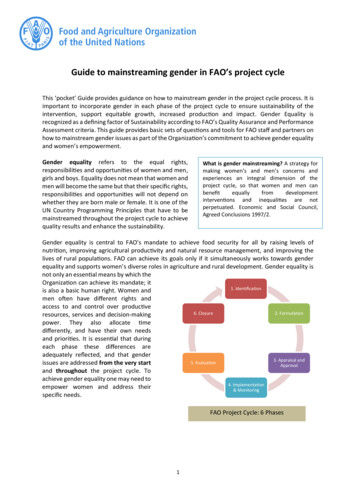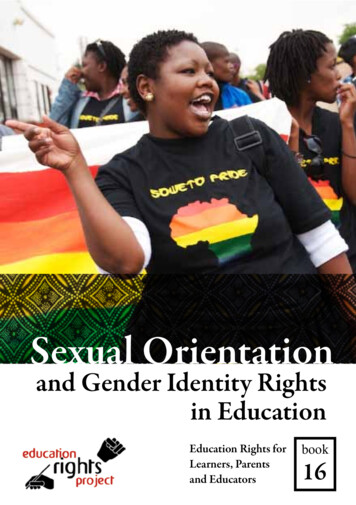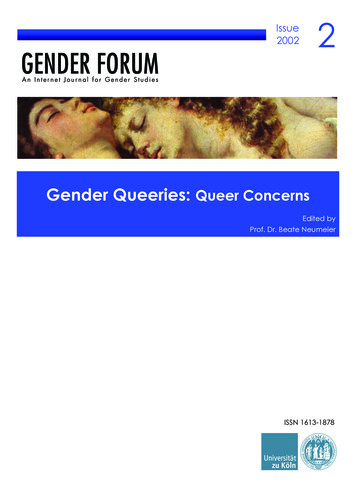
Transcription
2Issue2002Gender Queeries: Queer ConcernsEdited byProf. Dr. Beate NeumeierISSN 1613-1878
EditorAboutProf. Dr. Beate NeumeierGender forum is an online, peer reviewed academicjournal dedicated to the discussion of gender issues. Asan electronic journal, gender forum offers a free-ofcharge platform for the discussion of gender-relatedtopics in the fields of literary and cultural production,media and the arts as well as politics, the naturalsciences, medicine, the law, religion and philosophy.Inaugurated by Prof. Dr. Beate Neumeier in 2002, thequarterly issues of the journal have focused on amultitude of questions from different theoreticalperspectives of feminist criticism, queer theory, andmasculinity studies. gender forum also includes reviewsand occasionally interviews, fictional pieces and poetrywith a gender studies angle.University of CologneEnglish DepartmentAlbertus-Magnus-PlatzD-50923 Köln/CologneGermanyTel 49-(0)221-470 2284Fax 49-(0)221-470 6725email: gender-forum@uni-koeln.deEditorial OfficeLaura-Marie Schnitzler, MASarah Youssef, MAChristian Zeitz (General Assistant, Reviews)Tel.: 49-(0)221-470 3030/3035email: gender-forum@uni-koeln.deEditorial BoardProf. Dr. Mita Banerjee,Johannes Gutenberg University Mainz (Germany)Prof. Dr. Nilufer E. Bharucha,University of Mumbai (India)Associate Prof. Dr. Carmen Birkle,Philipps-Universität Marburg (Germany)Prof. Dr. Ingrid Hotz-Davies,Eberhard Karls University Tübingen (Germany)Prof. Dr. Ralph Poole,University of Salzburg (Austria)Prof. Dr. Kathryn Schaffer,University of Adelaide (Australia)Prof. Dr. Chris Weedon,Cardiff University (UK)Editorial DeadlinesSpring Issue:abstracts (October 1),completed papers (January 1)Summer Issue:abstracts (January 1),completed papers (April 1)Fall Issue:abstracts (April 1),completed papers (July 1)Early Career Researchers Special Issue:abstracts (May 1),completed papers (August 1)Winter Issue:abstracts (July 1),completed papers (October 1)Opinions expressed in articles published in gender forumare those of individual authors and not necessarilyendorsed by the editors of gender forum.SubmissionsTarget articles should conform to current MLA Style (8thedition) and should be between 5,000 and 8,000 words inlength. Please make sure to number your paragraphsand include a bio-blurb and an abstract of roughly 300words. Files should be sent as email attachments in Wordformat. Please send your manuscripts to genderforum@uni-koeln.de.We always welcome reviews on recent releases inGender Studies! Submitted reviews should conform tocurrent MLA Style (8th edition), have numberedparagraphs, and should be between 750 and 1,000words in length. Please note that the reviewed releasesought to be no older than 24 months. In most cases, weare able to secure a review copy for contributors.Article PublishingThe journal aims to provide rapid publication of researchthrough a continuous publication model. All submissionsare subject to peer review. Articles should not be underreview by any other journal when submitted to Genderforum.Authors retain copyright of their work and articles arepublished under a Creative Commons licence.There are no submission or page charges, and no colourcharges.
Detailed Table Of ContentsEditorial1Ulrike E. Tancke and Anja Müller-Wood: The Hidden Misogynies of Queering"light": The Case of The Hours3Chris Michael: "Femme(inine) Diaspora": Queering the Lesbian Femme15Susanne Jung: Queering Popular Culture: Female Spectators and the Appeal ofWriting Slash Fan Fiction30Dimple Godiwala: Aunt Mary: The Dialectics of Desire50Susanne Gruss: “People confuse personal relations with legal structures.” AnInterview with Margaret Atwood58Georg Brunner (Review): Jeffrey Weeks: Sexuality: Second Edition68Aldona Pobutsky (Review): Tamar Heller and Patricia Moran (eds.). Scenes ofthe Apple. Food and the Female Body in Nineteenth- and Twentieth-Century70Isabel Karremann (Review): Sylvia von Arx, Sabine Gisin, Ita Grosz-Ganzoni,Monika Leuzinger, Andreas Sidler (eds.). Koordinaten der Männlichkeit:Orientierungsversuche73Samantha Hume (Review): “Unless we realise, Unless we change, Unless wespeak.” Carol Shields: Unless75Julia Pascal: Theresienstadt81List of Contributors87
Editorial1The contributions to Gender Queeries explore conceptualisations and representationsof queerness in recent literary works and contemporary philosophical thought.2Anja Müller-Wood and Ulrike Tanke's essay "The Hidden Misogynies of Queering'light': The Case of The Hours" reconsiders Michael Cunningham's novel, which has recentlybeen turned into a film by Stephen Daldry. Although it was praised and marketed for itsqueerness and gender transgressions, Tanke and Müller-Wood argue that the book displaysboth misogynist traces and conventional gender patterns, and thus performs only a superficialqueering "light" of gender identity.3In "'Femme(inine) Diaspora': Queering the lesbian femme," Chris Michael contributesto the queer and feminist debate on the figure of the lesbian femme, whose subversivenessremains literally invisible from a point of view of gender performativity. Drawing on Frenchfeminist thought and recent queer theory, Michael uses notions of the subversive potential ofthe "feminine" and a diasporic model of queer identity and sexuality to develop an alternativeaccount of the femme that conceptualises her subversive power.4Susanne Jung's contribution "Queering Popular Culture: Female Spectators and theAppeal of Writing Slash Fiction" explores slash fiction, a form of queer fan fiction which isalmost exclusively written by female authors for a predominantly female readership. Inpresenting same-sex relationships of male TV characters, slash fiction strengthens thehomoerotic subtext of popular TV series. Being a slash fan fiction writer herself, Jung offers afascinating insight into the genre, which appears as critique not only of popular culture butalso of heterosexual hegemonic notions of gender and sexuality.5In her piece "Aunt Mary: The Dialectics of Desire," Dimple Godiwala calls attentionto Pam Gems' early play Aunt Mary, which anticipated much of the queer thought of thefollowing decades as early as 1982. Gems stages the shifting and fluid identities of threetransgendered, transvestite, and transsexual characters, thus presenting us with a spectacle ofdrag and queer.6"People confuse personal relations with legal structures," says Canadian authorMargaret Atwood in Susanne Gruss's interview. Atwood not only talks about her novels,particularly the latest science fiction Oryx and Crake, but also reflects on the meaningfeminism has for her and argues for a more specific definition of "feminist."7Following the interview with Julia Pascal published in gender forum's last issueAnybody's Concerns II, the fiction section of Gender Queeries features "Theresienstadt," a1
short story by the British-Jewish author which depicts an uncanny visit of a Jewish-Britishwoman to the erstwhile concentration camp.8Finally, a reading of Carol Shields' novel Unless as well as reviews of recentpublications within the field of gender studies by Tamar Heller and Patricia Moran, by Sylviavon Arx, Sabine Gisin, Ita Grosz-Ganzoni, Monika Leuzinger, and Andreas Sidler, and byJeffrey Weeks complete this issue.2
The Hidden Misogynies of Queering "light": The Case of The HoursBy Ulrike E. Tancke, University of Trier and Anja Müller-Wood, University ofMainz, GermanyAbstract:There is something enormously satisfying about a book that flatteringly addresses the readers'intellectual sophistication whilst leaving their deepest prejudices intact - this is queering"light" for those who want to seem in the know without knowing too much about themselves.In the end, nothing is truly "queered" - any aspects of the novel that may have invitedtransgression are subjected to the author's streamlining. At a closer look, it seems to be thevery ingenuity of the novel's structure that is the source of its hollowness and explains whythe frustrations with the book are so difficult to pin down: The Hours pretends to be what it isnot (deep and subversive), cleverly trying to disguise the fact that it is nothing more than asterile stylistic exercise not unlike those depicted (and condemned) in the novel."Look within and life, it seems, is very far from being 'like this'" (Woolf, "ModernFiction" 105)1If the praise-studded American paperback edition (1998) of Michael Cunningham'sThe Hours is anything to go by, the novel is a postmodern epiphany. Front and back cover ofthe book cite a string of raving reviewers from Manhattan to LA, who extol the novel for itselegant style and clever structure, its thematic depth and intensity and its subversive genderpolitics (whereby "subversion" is seen as anything from a merely benevolent view of womento the radical transgression of gender polarities). Cleverly juggling three different plotlinesthat join the Modernist author Virginia Woolf and two fictional American women - one livingin post-WWII suburban Los Angeles, the other in contemporary Manhattan - and thus, inbridging the gap between fact and fiction, connecting women across time and space, TheHours is celebrated as a treasure trove of incisive insights for readers and characters alike. Soilluminating is the novel that, in the words of one particularly enthusiastic critic, it will makethe reader "jump up from the sofa" (Ann Prichard on the front cover of Cunningham) - if itdoesn't, something might be seriously amiss with him or her.2Critical enthusiasm for The Hours is partly based on the claim that the noveltransgresses the traditional binary of feminine and masculine. Its unusual narrative situationwould seem to support the view that this book is a presumably radical exploration of genderidentity, an exercise in "queering." Here is a homosexual author writing about women,women of different sexual orientation to boot, who are, each in their own way, struggling ailparticularlyradicalreconceptualisations of gender? Nevertheless, although Cunningham does put forward theidea of a non-sexual third gender beyond the limits of femininity and masculinity, he fails to3
achieve the desired effect of transgression. If we take queer thinking to mean, subversively,"the resistance to regimes of the normal" (Warner xxvi), then The Hours cannot be awardedthat fashionable label. For the ideas Cunningham develops under the cloak of gender bendingare traditional if not plainly misogynistic, concurrently reiterating a hardly veiled venerationof precisely that masculinity which it claims to deny.3Given the general critical acclaim that the novel has gained, our verdict may seeminordinately harsh, if not conceited. Although the dust jacket encrustations in praise of TheHours may be nothing but symptomatic of an ailing publishing industry desperately trying toflog its products, it would seem forward to beg to differ with the unanimous barrage of criticalbonhomie bestowed upon The Hours, especially if a more sceptical view of the novel were tobe prompted by the film version of the book. However, far from watering down its source (asfilms, at least this is a prejudice common amongst literary critics, tend to do), Steven Daldry'scinema version (2002) enriches the book in a way that identifies those areas in the novel thatleave a lot to be desired. Above all, it points to the book's blatant failure (or is itunwillingness?) to create characters that are not caricatured incarnations of certain ways oflife, but human beings who call upon our empathy and understanding, and who - if one mayresort to categories from the days of a more morally-minded literary criticism - deal with theirguilt and responsibility in a believable way. It is true, through an apparently complexstructure, The Hours enables the author to raise existential and potentially disturbingquestions. Yet the novel suffers from weaknesses caused by precisely this stylistic cunning,which the comparison with the film might illuminate. In casting doubt over the ecstatic claimsof the book's critics, therefore, the film may act as a catalyst for the exploration of the voidunderneath the text's acclaimed structural ingenuity - a void that belies any surface "queering"that the novel's undeniably clever setup so deceptively suggests. In so doing, the film promptsthe kind of rigorous scrutiny that literary criticism is (or at least should be) all about.4This is not to disavow the book's undoubtedly ambitious intellectual scope, illustratednot least by the way Cunningham makes Virginia Woolf and her novel Mrs Dalloway thecentre of gravity around which he has his different plots revolve: In the 1920s, Virginia Woolfis working on her novel whilst struggling with a mental illness that has forced her to retire todull suburban Richmond for a "rest cure." In late 1940s Los Angeles, Laura Brown, mother ofthree-year-old Richard and pregnant with her second child, is trying to convince herself thatshe is satisfied with the life of a suburban "angel in the house" caring for her husband andchildren. Woolf's Mrs Dalloway keeps tempting her into a fictional world which voices herown unspoken depression. In New York, around the millennium, the lesbian publisher4
Clarissa Vaughan is preparing a party for her friend and former lover, writer Richard Brown,who is dying of AIDS; it is also he who once gave her the nickname "Mrs Dalloway." Woolf'snovel thus functions as the mediator between three very different female characters: VirginiaWoolf is writing it, Laura Brown is reading it, and Clarissa Vaughan is being constructed asthe fictional character's late-20th-century embodiment. Furthermore, Woolf serves asCunningham's nexus also on a metatextual level, as is suggested not only by the fact that TheHours was Woolf's working title for Mrs Dalloway, but also by a plethora of allusions to thatnovel and its author and a derivative, quasi modernist style.5How
10.01.2004 · and include a bio-blurb and an abstract of roughly 300 words. Files should be sent as email attachments in Word format. Please send your manuscripts to gender- forum@uni-koeln.de. We always welcome reviews on recent releases in Gender Studies! Submitted reviews should conform to current MLA Style (8th edition), have numbered paragraphs, and should be between 750 and 1,000 words in
